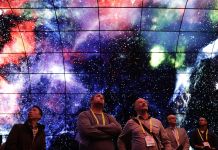Turns out Einstein was right. Again.
Scientists validated another of Einstein’s hypotheses when they confirmed in 2016 the existence of gravitational waves, which Einstein first predicted more than 100 years ago as part of his general theory of relativity.
Why is that important? As astrophysicist Jeffrey Bennett explained, Einstein’s general theory of relativity changed the way we understand the nature of space, time and gravity. Detecting gravitational waves reaffirms Einstein’s incredible achievement and will let scientists “probe some of the most exotic objects in the universe, including black holes,” Bennett wrote.
Science magazine named the discovery its top breakthrough of 2016, saying it “shook the scientific world.”
The best way to understand how it works is to watch the video below. It shows how two objects spinning around each other create waves. As the objects get closer to each other, the waves get bigger. (There is no sound with this video.)
Physicists at the Laser Interferometer Gravitational-Wave Observatory (LIGO), made up of two installations in Louisiana and Washington, confirmed that they had seen the waves caused by two black holes crashing into each other.
Since gravitational waves move through the universe in a way similar to the way audio waves move through the air, LIGO created a simulation of what the gravitational waves might sound like if they were audio waves. Listen to what it sounds like.
What can we do with this new discovery?
Scientists are excited about the discovery of gravitational waves because it could open up an entire new field of science.
Proving that the waves exist confirms that the universe behaves the way scientists thought. This is the first step toward building more sensitive machinery that will ultimately help scientists learn more about the planets, stars and black holes across the universe.
“This detection is the beginning of a new era,” said Gabriela González of the LIGO Scientific Collaboration, a group of more than 1,000 scientists from universities in the U.S. and 14 other countries. “The field of gravitational wave astronomy is now a reality,” said González, a professor of physics and astronomy at Louisiana State University.







![Immigrants find success in Silicon Valley’s venture capital industry [video] Two people in front of freshdesk logo (VOA)](https://webarchive.library.unt.edu/web/20170125111309im_/https://share.america.gov/wp-content/uploads/2017/01/maxresdefault-2-218x150.jpg)
![One approach for bringing jobs to low-income neighborhoods [video] David Williamson smiling, with text added (State Dept.)](https://webarchive.library.unt.edu/web/20170125111309im_/https://share.america.gov/wp-content/uploads/2016/12/maxresdefault-17-218x150.jpg)








![Look what has happened since the 2015 climate pact was adopted [video] Illustration of windmills on green hills (State Dept.)](https://webarchive.library.unt.edu/web/20170125111309im_/https://share.america.gov/wp-content/uploads/2016/12/Screen-Shot-2016-12-16-at-11.54.40-AM-218x150.jpg)







